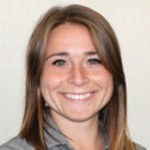
From the Week of October 9, 2023
The one-stop-shop for everything you need to know about what’s happening this week in your fields.
This week’s featured agronomists are:
Adam Steffel – Belle Plaine
Chris Soltau – Goodhue
Joe Dee – Morristown
Hailey Hausladen – Stewartville
Kirsten Bauer – Ellsworth
Scroll down to hear from your local agronomist!
WEST
Belle Plaine – Le Center – Le Sueur

Adam Steffel
Harvest is in full swing, and a lot of yield reports are coming in. We are seeing a lot of soybean yields being consistent around the 60 bushels to the acre mark and for the little bit of corn reports we have seen so far, it has been anywhere from 190 to 240 bushels to the acre.
One unique thing we have seen in a few soybean fields this past week is Green Stem Syndrome. This is when there are soybean plants that still have green stems and sometimes green leaves on them. The plant shown below shows another symptom that can be expressed, which is having immature green pods that are clustered throughout the plant. There is no proven evidence on what exactly causes this, but it is thought that different stresses may be linked to it like bugs, diseases, and moisture stress.

EAST
Pine Island – Cannon Falls – Goodhue – Lake City
2023 has been the first year I was truly concerned about a devastating drought in the 29 Springs I have been here in Goodhue. Where I grew up in LeRoy is worse than Goodhue for moisture. It’s a fine line between enough rain to survive and just not enough for the crop. I was pessimistic on the soybeans with seed size being small and not seeing the number of beans in a pod. Most everyone I have talked to has been pleasantly surprised on their yields. The early reports on the corn from yields and insurance checks has been much better than we thought a month ago.
Those who stayed with their fungicide, herbicide, and fertility plan are glad they did. Fungicide beans are more even across the field and fungicide corn is showing more late season plant health. This is not a surprise, because the we typically se plant health benefits in dry years.
I have never met a farmer who isn’t proud of good yields. Everyone I have talked to is thankful what their yield has been for corn and soybeans. Of course, one always wants more. For those who did stick to their plan will have better yields than if they did not.
CENTRAL
Morristown – Wanamingo – Kenyon

Joe Dee
Press Play for Joe’s video report!
SOUTH
Elgin – Lewiston – Stewartville
 Hailey Hausladen
Hailey Hausladen
Fall, my favorite time of year, is in full swing! The soybeans that are left are hopefully going to finish up before we get another shot of rain this week, and we are making good headway on corn! Both crops have been all over the board for yield this year. Soybeans are averaging anywhere from 30’s to 70’s and corn is having just as large of swing, with averages ranging anywhere from 150-220 bushels. We are now busy spreading fall fertilizer, preparing for next year’s crop! 2023 will definitely be a year to remember. I hope everyone has a safe fall and a great harvest!

WISCONSIN
Ellsworth
 Kirsten Bauer
Kirsten Bauer
Harvest 2023 has taken off and combines cover the countryside here in Western Wisconsin as we begin to switch gears from soybeans to corn. The USDA Crop Progress report states WI corn grain harvest is about 9% done and corn silage is wrapping up at about 83% done. That said, as we look ahead to wrapping up the 2023 season, 2024 is knocking on the door and preparations for its arrival starts with soil sampling and fertilizer. Fertilizer rates and timing especially for nutrients like potassium can be a highly debated topic, and that’s no wonder when potassium levels (especially in Wisconsin) have continually been a high limiting factor for yield. While much of this limitation is based on moisture/rainfall, which is beyond our control, what we can manage is our rates and timing of application. Often, we prioritize fall P and K applications for the sake of freeing up time in the spring, or to pair up its incorporation with our fall tillage schedule, but the yield advantage alone we sometimes forget. If we look at a collection of AYS data from Western WI across 6 years (2017-2022) it shows a significant yield bump across the board between fields that received K applications in the fall, and those that did in the spring.

(Corn showed an 11 bu/acre increase and Corn-on-Corn an 18 bu/acre increase)
We should also ask ourselves, even if we have the timing right, are we maximizing rates to give us the best ROI? With new response data and increasing yield levels, Iowa State University has increased their recommended optimum level of K from 170 ppm to 250 ppm. If we look at 5 years of data from our AYS system across all our acres of corn and beans in WI, the majority fall in the soil test levels of 70-100 ppm of K and 120-150 ppm of K (L).

Our data shows that even in soils with high test levels of K we still see a yield return when we push our applications past that 90-120lb K20 rate. Especially where the majority of our acres sit in that 70-100ppm range, with even 30 more lbs of actual K (50 lbs of potash, currently at around $12/acre) we see an 11 bu/acre bump on corn and 1-5 bu on beans. When making any changes to our fertilizer applications we should be mindful of factors like our soil types and CEC, but the amount of variability on many of our acres means we have a lot of untapped yield potential with the proper management. Be sure to talk to your local Ag Partners Agronomist and AYS Specialist about your fertility, and planning for the 2024 crop season. Happy Harvest!




